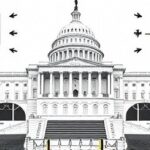As the U.S. Government shutdown stretches into its third week, millions of low-income Americans are bracing for potential disruptions to their SNAP benefits, the nation’s largest food assistance program. With November payments at risk, families could face empty pantries just as holiday demands intensify, sending shockwaves through grocery spending and local economies nationwide.
SNAP Recipients on Edge as Funding Uncertainty Grows
The Supplemental Nutrition Assistance Program (SNAP), formerly known as food stamps, provides vital support to over 41 million people each month, according to the U.S. Department of Agriculture (USDA). These benefits, averaging about $250 per household, help cover essential grocery costs for vulnerable populations including children, seniors, and working families. But with federal funding frozen due to the ongoing Government shutdown, state agencies that administer SNAP are warning of delays or interruptions in November’s distributions.
Officials in states like California and New York, which host some of the largest SNAP caseloads, have already notified recipients of possible glitches in the Electronic Benefits Transfer (EBT) systems. “We’re doing everything we can to mitigate the impact, but without federal appropriations, our hands are tied,” said Maria Gonzalez, director of California’s Department of Social Services. This uncertainty has left many recipients anxious, with reports of stockpiling non-perishables in anticipation of shortfalls.
Statistics underscore the scale of the potential crisis: In fiscal year 2023, SNAP disbursed over $119 billion in benefits, preventing an estimated 8 million people from falling into poverty. A prolonged shutdown could exacerbate food insecurity rates, which already affect 13.5% of U.S. households, per the USDA’s latest data. For single-parent households, where 70% rely on SNAP, the stakes are particularly high as grocery spending patterns shift toward cheaper, less nutritious options during disruptions.
- Over 41 million monthly SNAP participants at risk.
- Average benefit: $250 per household, critical for food assistance.
- States like Texas and Florida report surging inquiries about benefit timelines.
Personal stories are emerging from the front lines. In Chicago, single mother Angela Rivera, who relies on SNAP for her two young children, shared her fears: “If my card doesn’t load next month, I don’t know how we’ll eat. This shutdown isn’t just politics—it’s our dinner table.” Such testimonials highlight how SNAP benefits are more than financial aid; they’re a lifeline woven into daily survival.
Shutdown Timeline: From Budget Stalemate to Benefit Blackout Fears
The current Government shutdown began on October 1, 2024, triggered by congressional disagreements over a continuing resolution to fund federal operations. As negotiations drag on, non-essential services have halted, but essential programs like SNAP were initially buffered by prior appropriations. However, those reserves are depleting rapidly, with experts predicting exhaustion by mid-November.
The USDA, operating on a skeleton crew during the shutdown, has prioritized benefit processing but faces mounting backlogs. In previous shutdowns, such as the 35-day impasse in 2018-2019, SNAP payments were delayed for weeks in some states, leading to a 10% spike in emergency food bank visits. This time, with inflation driving up food prices by 25% since 2020, the margin for error is even slimmer.
State-level responses vary. New Jersey has tapped into contingency funds to cover October benefits, but officials warn that November’s $1.2 billion allocation remains precarious. Meanwhile, in rural areas of the Midwest, where SNAP usage is high among farmers and seasonal workers, local food pantries are preparing for influxes. “We’ve seen a 15% increase in demand already, and that’s without the full shutdown effects,” noted Tom Ellis, executive director of the Feeding America network.
- October 1: Shutdown commences amid budget disputes.
- Mid-October: Initial SNAP payments issued from reserves.
- Early November: Potential disruptions as funds dwindle.
- Late November: Risk of EBT system failures if unresolved.
Economists point to the 2013 shutdown, when SNAP delays cost the economy $1.5 billion in lost productivity as families scrambled for alternatives. Today, with e-commerce grocery options limited for low-income users, the reliance on physical stores amplifies the urgency.
Grocery Spending Slump: Retailers Brace for Holiday Hit
The ripple effects of potential SNAP benefits disruptions extend far beyond individual households, threatening to curb grocery spending at a critical time for retailers. SNAP accounts for about 7% of total U.S. grocery sales, injecting $70 billion annually into the food sector. A November shortfall could shave off up to $5 billion in immediate spending, according to projections from the Food Research & Action Center (FRAC).
Major chains like Walmart and Kroger, which accept EBT cards at thousands of locations, are monitoring the situation closely. “Any delay in benefits directly impacts our low-price leadership model, as these customers drive volume in staples like milk, bread, and produce,” said a Kroger spokesperson. Smaller independent grocers in urban and rural local economies face even steeper challenges, with some predicting 20-30% revenue drops if benefits falter.
In cities like Detroit, where SNAP fuels 25% of grocery transactions, community markets are already feeling the pinch. Vendor Maria Lopez reported a slowdown in foot traffic: “People are holding back, waiting to see if their cards work. It’s killing our margins during what should be peak season.” This hesitation could compound into broader economic drags, as reduced grocery spending affects suppliers, truckers, and farm workers in interconnected supply chains.
Broader data from the Census Bureau shows that during past disruptions, SNAP-dependent areas saw a 12% decline in retail food sales within weeks. With Thanksgiving approaching, the timing couldn’t be worse—turkey prices are up 15% year-over-year, straining budgets further. Analysts warn that if unresolved, this could lead to a domino effect, boosting demand for alternative food assistance like WIC or school meals, overwhelming those systems too.
Economists Predict Short-Term Pain but Long-Term Resilience
While the immediate outlook is grim, many economists view the SNAP benefits disruptions as transitory, contingent on a swift resolution to the government shutdown. Dr. Elena Vasquez, an economist at the Brookings Institution, explained: “Historically, these interruptions last no more than a month, and back payments are issued retroactively. The economy’s resilience means local economy recoveries are quick once funds flow again.”
Indeed, during the 2018 shutdown, grocery spending rebounded fully within two months, with minimal lasting impact on inflation or unemployment. Current models from the Federal Reserve suggest that even a full November delay would trim GDP growth by just 0.2%, a blip compared to pandemic-era shocks. However, Vasquez cautioned that repeated shutdowns erode trust in food assistance programs, potentially increasing administrative costs by 5-10% in future cycles.
Stakeholders from across the aisle are weighing in. Senate Majority Leader Chuck Schumer urged bipartisan action: “We can’t let politics starve families—SNAP is a bipartisan success story that must be protected.” On the other side, House Speaker Mike Johnson emphasized fiscal responsibility but acknowledged the human cost: “No one wants to see benefits delayed; we’re working toward a balanced resolution.”
Nonprofits like Feeding America are ramping up advocacy, lobbying for emergency waivers that could allow states to issue IOUs or bridge funding. Their efforts have already secured $500 million in private donations for food banks, a buffer against the worst scenarios.
Path Forward: Bipartisan Talks and Emergency Measures in Focus
As pressure mounts, White House officials are signaling intensified negotiations to end the government shutdown before November’s benefit deadlines. A proposed deal, floated last week, includes temporary funding for essential services like SNAP, potentially unlocking $20 billion for food programs through December. If passed, this could avert the crisis, restoring normalcy to grocery spending and stabilizing local economies.
Advocacy groups are pushing for long-term reforms, such as automating SNAP funding to insulate it from shutdowns, a measure supported by 80% of polled economists. In the interim, states are exploring partnerships with retailers for deferred payments or loyalty programs tailored to EBT users. For instance, Alabama’s pilot program offers 10% discounts on essentials for affected families, a model that could scale nationally.
Looking ahead, the implications extend to 2025 budgets, where lawmakers may prioritize resilience in food assistance amid rising costs. Families like the Riveras are hopeful but vigilant, monitoring updates via apps and community alerts. If history is any guide, resolution will come—but not without underscoring the fragility of America’s social safety net in an era of political gridlock. As one expert put it, “This shutdown tests our priorities: Will we feed our people first, or let ideology linger?” The coming days will reveal the answer, with millions depending on it.









